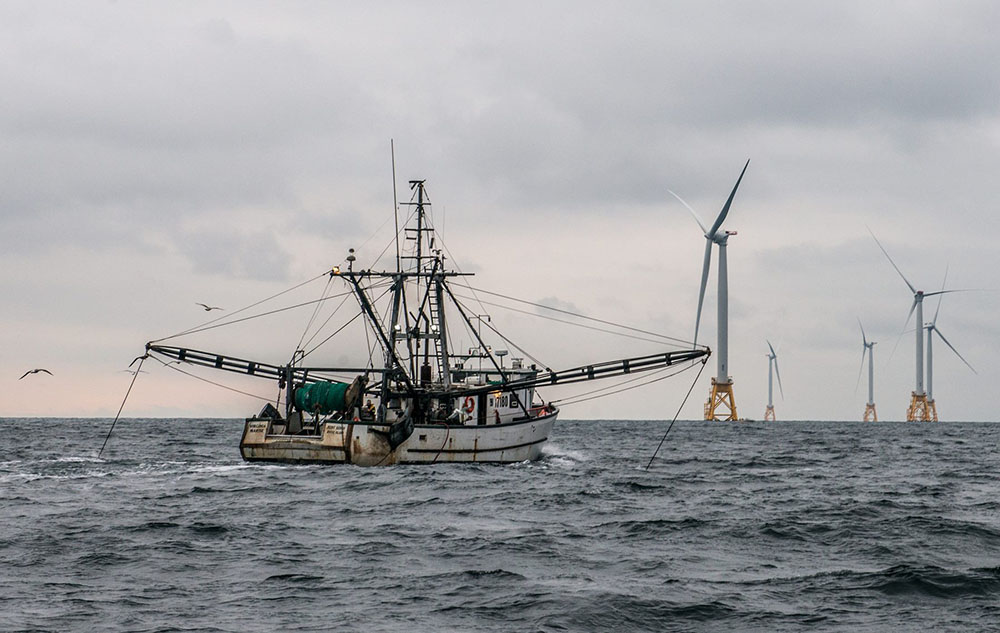The federal Bureau of Offshore Energy Management is requiring offshore wind energy developers to set aside vessel transit corridors, amid intense discussions with the commercial fishing industry.
In a notice published Friday in the Federal Register, the agency announced it would offer an additional 390,000 acres south of Massachusetts for lease on Dec. 13. That would extend large areas already leased from Block Island, R.I., to south of Martha’s Vineyard.

The Bureau of Offshore Energy Management says it will require vessel transit corridors (shown in light blue) through offshore wind energy leases off New England. BOEM image.
The BOEM notice includes a new requirement for planning safe transit lanes through future arrays of turbine towers on the shallow continental shelf.
At a Sept. 20 meeting in Massachusetts, Coast Guard officials and fishing industry groups proposed transit lanes through the leases to BOEM and wind developers Baystate Wind, Vineyard Wind and Deepwater Wind (now merging with Danish energy company Ørsted).
“Representatives from the squid, groundfish, scallop, and other fisheries agreed that the two nautical-mile-wide transit corridors through the existing leases would provide the ability to safely transit to and from the fishing grounds. BOEM expects these, or similar, transit corridors to be finalized in the near future, and future lessees will be required to incorporate them into their plans,” the lease sale notice states.
After the lanes were proposed at the Sept. 20 meeting in Massachusetts, “certain interests have stated that they will not support the recommendation, and there now is a great deal of uncertainty regarding what transit lanes will ultimately be proposed and approved” by BOEM, the group said in its announcement.
The workshop is to consider “minor revisions” to the Massachusetts document so there can be certainty around the transit lanes. The meeting will also allow the fishing industry to recommend how Vineyard Wind can develop a plan for mitigating the impact of its development on fishing, the group says.

The Responsible Offshore Development Alliance is seeking to finalize a fishing industry consensus on traffic lanes. RODA image.
Another proposal, the Deepwater Wind South Fork Wind project 19 miles southeast of Block Island, has been bitterly opposed by New York and Rhode Island fishing groups. BOEM is preparing an environmental impact statement on the proposal, and initiated a public comment period to run to Nov. 19.
Critics of offshore wind, including a number of commercial fishing groups, have urged the Trump administration to put the brakes on development and take a slower approach. But Secretary of Interior Ryan Zinke has emerged as a strong advocate off building a U.S. offshore wind industry.
“The Massachusetts sale has a lot of potential for both energy and economic activity,” Zinke said Thursday when he announced the plans at the American Wind Energy Association’s Offshore Wind Conference in Washington, D.C.
“If fully developed, the wind auction could support approximately 4.1 gigawatts of power to supply nearly 1.5 million homes. This is just one example of the importance of fostering wind energy as a new American industry.”

The first West Coast offshore wind energy areas could be leased off California. BOEM image.
BOEM identified three areas dubbed Humboldt, off Eureka, Calif., on the state’s north coast, and Morro Bay and Diablo Canyon off the central coast. Those “call areas” comprising 687,823 acres on the are the first step in a process to potentially open them to leasing by wind developers, the same process that to date had yielded a dozen East Coast wind projects now in various planning stages.
Unlike those leases on the shallow, sandy Atlantic bottom, California wind development by necessity would require use of floating turbines.
Equinor has the Hywind five-turbine floating array as a demonstration project off Scotland. The University of Maine is testing its Maine Aqua Ventus floating turbine design that backers hope could open the deeper, rocky Gulf of Maine into a new frontier for wind development that already has a foothold in southern New England.
Like state governments in the Northeast, California energy planners have big ambitions for renewable energy. But offshore wind energy is certain to get a high degree of scrutiny under California’s other environmental laws and policies protecting the coast, where development of all kinds is highly restricted.







